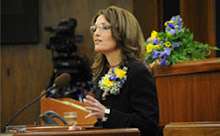Spectrum
Published in the Mat-Su Valley Frontiersman on Saturday, June 27, 2009 10:12 PM AKDT
It is important for Alaskans to know that while state legislators resolved to accept all federal stimulus funds, I vetoed $28.6 million for state energy programs because it came with conditions. Many have looked at this money and did not see any strings. I can assure you, if we accept these funds there is great potential for Alaska to find itself on the hook (Palin, 2009, ¶1).
Let me set the record straight: Alaska has made significant investments to reduce energy costs. In fiscal years 2009 and 2010, we committed more than $600 million for renewable energy, weatherization, home energy rebates, power cost equalization and heating assistance (Palin, 2009, ¶2).
In addition, Alaska will receive $18.5 million for weatherization and $9.6 million for energy efficiency from the federal stimulus package. But the other $28.6 million comes with strings attached (Palin, 2009, ¶3).
Statements made by Congress and the U.S. Department of Energy (USDOE) on conditions for receiving the stimulus funds are available in statutory language and guidance. These statements highlight that: (Palin, 2009, ¶4)
- Before the stimulus bill passed, it was clear Congress intended to tie the funds to adoption of new energy building codes (Palin, 2009, ¶5).
- When Congress passed the bill, section 410’s language was clear: governors had to certify in writing that their state or all local jurisdictions with authority to adopt building codes would “implement” the new energy building codes or their equivalent (Palin, 2009, ¶6).
- After the stimulus passed, the USDOE confirmed in their March 12 and April 24 guidance manuals that funding was only available if governors would confirm in writing that the state or all local jurisdictions with authority to adopt building codes “will implement” the target codes or their equivalents (Palin, 2009, ¶7).
- After Alaska pointed out that its requirements were unreasonable, USDOE admitted the requirements were “not appropriate” for every state and offered to accept instead, a promise by the governor to promote the target codes on Alaska communities (Palin, 2009, ¶8).
- On June 6, 2009, USDOE’s contractor developing measurement and reporting requirements related to energy building codes repeated in writing the position that all local communities without the target codes or an equivalent had to adopt the target codes (Palin, 2009, ¶9).
The bottom lines are: (Palin, 2009, ¶10)
- My administration was well-justified in its interpretations of what section 410 and USDOE statements were requiring as conditions to qualify for the funds. In some cases, the conditions were greater in scope than what the Legislature found (Palin, 2009, ¶11).
- While USDOE admitted that their requirements were not appropriate for every state, the department was still requiring the governor to push the target codes on Alaska communities (Palin, 2009, ¶11).
- In the June 6, 2009, draft compliance document, USDOE again put a position in writing that codes must be adopted. USDOE appears to be giving inconsistent verbal statements on its position. The fact that USDOE cannot settle on a position is cause for concern particularly regarding what USDOE will ultimately require from states who accept the funds (Palin, 2009, ¶12).
- Section 410 requires adoption of the 2009 International Energy Code for residential buildings and the Standard 90.1-2007 for commercial buildings or their equivalents. So, it is a single standard for energy savings that must be met by all communities. In that sense it is a one-size-fits-all type requirement. Communities may have some leeway to shape their specific codes, but they still have to adopt a code that does not drop below the federally mandated “floor” for energy savings (Palin, 2009, ¶13).
It is unclear what changes could be made and still reach the minimum savings level set by the feds. This intrudes on the authority of local governments (Palin, 2009, ¶14).
While the draft guidelines are voluntary for now, Alaskans should not be complacent. These guidelines could very well become mandatory over the next few years and be used by the USDOE to conclude that a particular state is not in compliance (Palin, 2009, ¶15).
Alaska is already a leader among states in pursuing conservation, weatherization, and renewable energy. We’ve done so largely with state funds and without infringing on the local authority of Alaska communities (Palin, 2009, ¶16).
Sarah Palin is governor of Alaska.
Commentary
It's too bad, Sarah Palin is not President of the United States, though in many respects she is doing his job for him and doing it very well, as we have seen with her overseas trip.
Governor Palin built a strong, cogent case as why she vetoed this poisoned money -- it comes complete with breaches of the Tenth Amendment. Local Alaskan communities manage their energy matters just fine without federal interference and its concomitant costs.
References
Palin, S.L.H. (2009, June 27). "One more time on federal energy funds." Mat-Su Valley Frontiersman. Retrieved June 28, 2009 from: http://www.frontiersman.com/articles/2009/06/28/opinion/columnists/doc4a4707cbc96ed839059305.txt
En Español:
한국어 (Korean)
עִברִית (Hebrew)
日本語 (Japanese)
繁體中文 (Traditional Chinese)
































